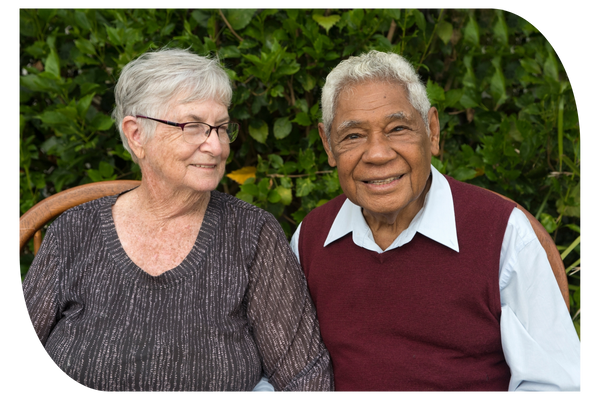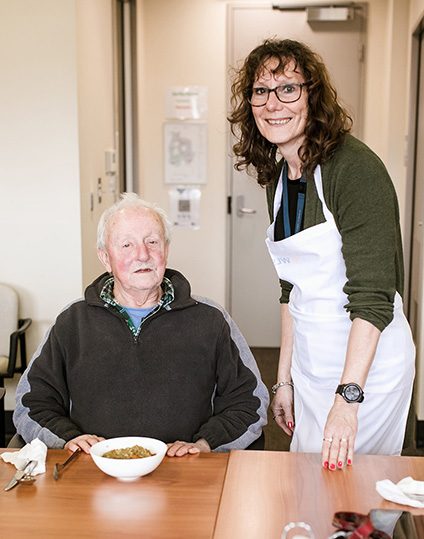Find out more about:

- What is the Support at Home program and how does it work in Victoria?
- How Latrobe Community Health Service is different to other in-home aged care providers
- What types of services are available through Support at Home?
- What are the eight Support at Home funding levels?
- What are the everyday living, independence, and clinical support categories?
- How much will I pay for Support at Home services?
- What is the care management fee for Support at Home?
- How do I apply for Support at Home services through My Aged Care?
- How do I change my Support at Home services to another provider?
- Which in-home aged care services are near me?
- Who do I speak to for more information about Support at Home?
What is the Support at Home program and how does it work in Victoria?
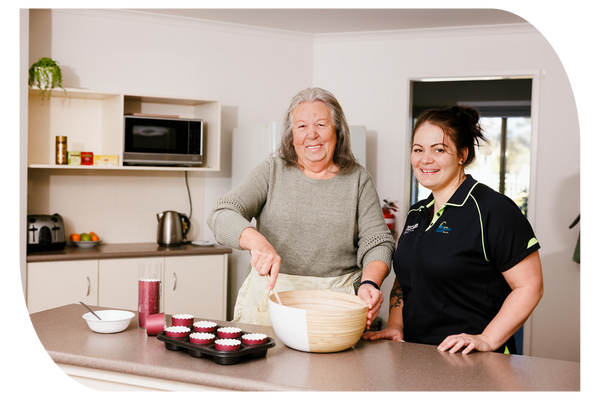
You love living at home. You’re happy there – but some things are becoming a bit harder to manage.
Support at Home funding may provide the help you need.
The Federal Government provides funding to eligible Australians over the age of 65, and to Aboriginal and Torres Strait Islanders over the age of 50, to help them live at home for longer.
Support at Home funding pays for services tailored to meet your specific care needs – and Latrobe Community Health Service coordinates and manages those services for you.
How Latrobe Community Health Service is different to other in-home aged care providers
1. Latrobe Community Health Service staff live where you live – they are deeply connected to your community. They work in home care because they want to make a difference.
2. We offer all of your health and support services under one roof, with a tight-knit team working as one to deliver your care.
Our breadth of services is unmatched. We deliver more than 100 health and community care programs, including domestic assistance, GPs, dental, nursing, mental health practitioners, podiatrists, physiotherapists, occupational therapists, dietitians and many others.
3. Latrobe Community Health Service is a secular, not-for-profit organisation that reinvests its income into providing even more community and health services.

What types of services are available through Support at Home?
- · Personal care: Help with bathing, showering and toileting (and equipment to make these tasks easier)
- Devices that keep you safe: Equipment that helps with getting in and out of bed, your car or the bath, or getting on and off the toilet or a chair – these include bed rails, slide sheets and frames
- Equipment that keeps you mobile: Walking frames, wheelchairs or mobility scooters
- Continence management: Clinical assessments, healthcare support and aids like bed pans and commodes
- Skin care: Bandages, dressings and lotions that maintain healthy skin
- Meals: Meal preparation
- In-home respite care: A support worker can stay with you while your primary carer takes a break
- Technology: Personal alarms, motion sensors and devices that keep you safe, and alert your family if something is amiss
- Housework: General house cleaning such as vacuuming, mopping, changing linen, cleaning wet areas, laundry and ironing
- Lawn and home maintenance: Support workers keep your home and garden in a safe, functional condition
- Home modifications: Minor renovations that improve your safety at home, such as the installation of easy access taps, bath rails or ramps (following an occupational therapy assessment and recommendation)
- Home assessments and advice: Expert advice on major home renovations and how to reduce your risk of falls
- Transport: Help to get you safely to and from the shops, and attend appointments and social activities – this could be in the form of a support worker driving you where you need to go
- Shopping: A support worker goes shopping with you, or does your grocery shopping on your behalf
- Personal interests: Access to community-based groups, such as the men’s shed or country women’s association, and someone who can go for a walk with you or take you to the movies
- Nursing, allied health and therapy services: Speech therapy, podiatry, occupational therapy and physiotherapy
- Specialised care: Services, aids and therapy that help to prevent or manage conditions such as vision, hearing or cognitive impairments
What are the eight Support at Home funding levels?
The Australian Government-funded Support at Home program has eight levels of support. You use this money to purchase in-home aged care services.
What are the everyday living, independence, and clinical support categories?
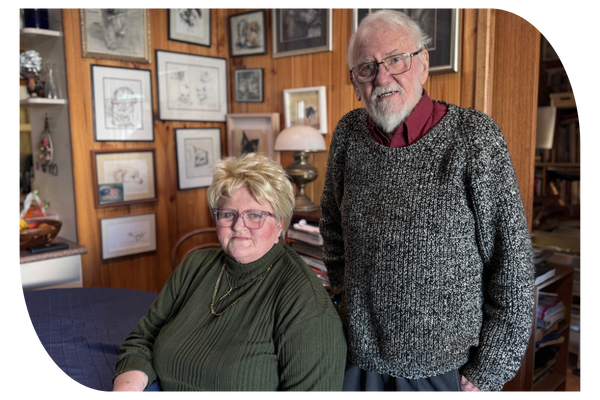
Under the Support at Home program, there is a clearly defined list of home care services you can spend your funding on. All services fall into one of three categories:
1. Clinical supports
These are services delivered by (or supervised by) university qualified or accredited health professionals. It includes nursing, allied health, nutrition and care management.
2. Independence
This is support to help manage activities of daily living. It includes personal care, community engagement, respite, and some transport.
3. Everyday living
This is support to stay independent at home. Examples include domestic assistance, home maintenance, and meals.
How much will I pay for Support at Home services?
If you are approved to receive Support at Home funding, the Australian Government requires you to contribute financially to your care.
How much you contribute will depend on an assessment of your income and assets. The client contribution also varies depending on whether your service relates to clinical support, independence supports, or everyday living supports.
This table shows the indicative contribution rates. Your exact contribution will depend on your income and assets assessment.
You can read more about Support at Home costs and fees here.
What is the care management fee for Support at Home?
Latrobe Community Health Service is a care partner. We provide aged care services throughout Victoria. Our role is to work alongside you to create a plan for how to best use your Support at Home funding. Then we coordinate and manage the mix of services you need.
Ten percent of your Support at Home funding is allocated to Latrobe Community Health Service so we can provide coordination and management of your in-home aged care services.
The remainder of your Support at Home funding is used to purchase services.
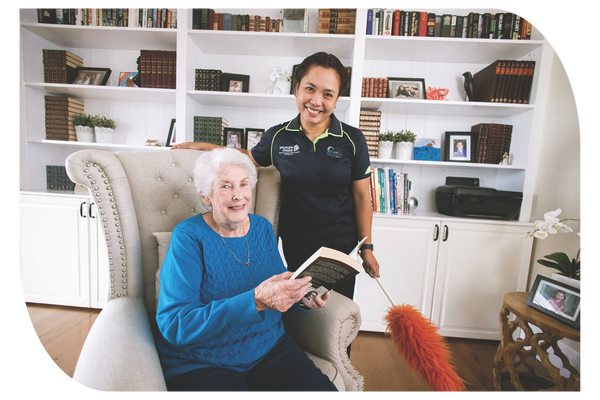
How do I apply for Support at Home services through My Aged Care?
Whatever your aged care needs, the first step is to register with the Australian Government’s My Aged Care service. After you have done this, you will be assessed to see what kinds of support you need, and what funding you may be eligible for.
You can register online, by phone, or in person. Click here to learn more about registering with My Aged Care.
If you would like additional support, Latrobe Community Health Service can help you. Call 1800 242 696 and ask to speak to the Support at Home team.
Read more about how to apply for Support at Home services through My Aged Care.

How do I change my Support at Home services to another provider?
Changing your Support at Home care partner has never been easier. If you would like to change your provider to Latrobe Community Health Service, call 1800 242 696 and ask to speak with the Support at Home team. They will ask you a few straightforward questions, then start the transfer process on your behalf. At all times we work with your current care partner to ensure the services you need are maintained during the transfer process.
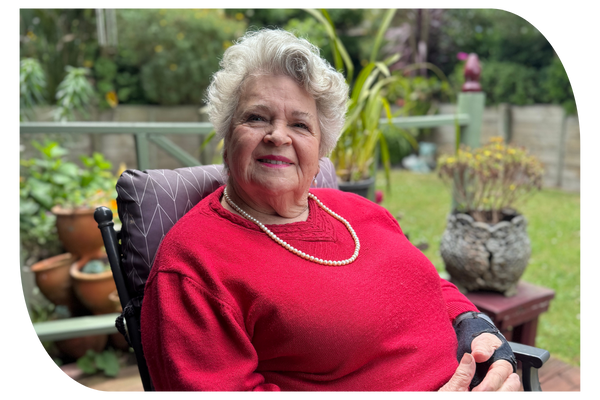
Which in-home aged care services are near me?
Latrobe Community Health Service provides in-home aged care services throughout metropolitan Melbourne and regional Victoria. We have nearly 40 sites across the state, ensuring there is a local Support at Home office near you.
Click here to see a complete list of Latrobe Community Health Service sites.
Who do I speak to for more information about Support at Home?
We want to provide very clear, easy to understand information about in-home aged care. Whatever you question, we will provide jargon-free advice for you. Simply call 1800 242 696, or fill out the form below to request a call back.
